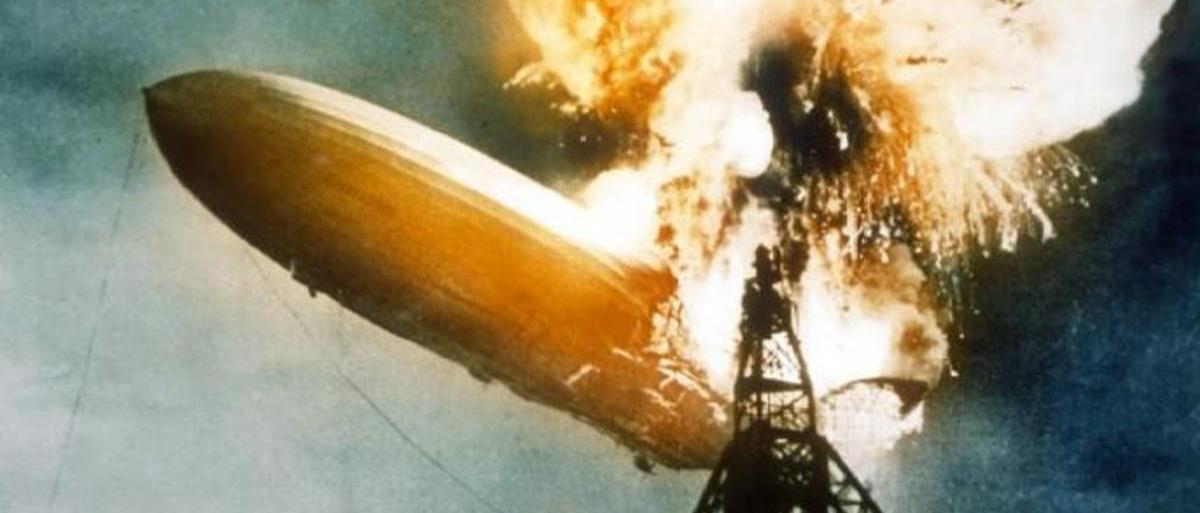Hindenburg Disaster
Posted on 16th July 2021
The 1930’s was a time when air travel was still in its infancy. It had only been in June 1919 that the British aviators Alcock and Brown made the first non-stop trans-Atlantic flight while the first person to do so solo was the American Charles Lindbergh in May 1927. Despite these successes however, it remained a dangerous venture and many others had died attempting it so the very idea of carrying significant numbers of passengers across the Atlantic Ocean by airplane remained in the realm of the fantastical.
But Airships were another matter and had first come to prominence during the Great War when the German Zeppelin Company had built them to bomb targets in Great Britain and France, now they adapted them to carry passengers.
Between 1928 and 1936 the small Airship Graf Zeppelin made 72 relatively trouble-free return journeys across the Atlantic mostly to South America. It was proof that long-distance air travel was viable and in 1935 the Government in Germany commissioned the Hindenburg to be its grander more luxuriant replacement. Both the Reich Minister Hermann Goering and the Propaganda Minister Joseph Goebbels were eager for the Hindenburg to be a flag- waiving propaganda tool for the Nazi Regime even if the man responsible for its construction Hugo Eckener was not.
The Graf Zeppelin had been cramped for space and designed to carry mostly mail and so had capacity for at most only twenty fee paying passengers. The Hindenburg was to be 804 feet long, 135 feet high, and have 7,062,100 feet of cubic gas capacity. It was also to use the more flammable hydrogen rather than the safer but less effective helium.
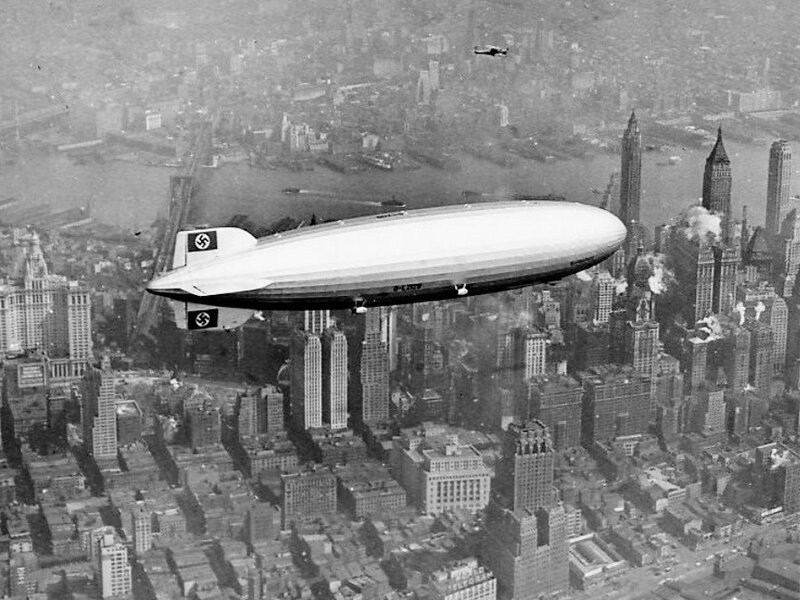
The Hindenburg had two decks: Deck A had a lounge for the passengers with windows that opened providing them with a panoramic view and access to a promenade. Because weight had to be kept to a minimum everything on board was made as as light as possible and so the chairs and tables were made of aluminium as also was the grand piano: Deck B was reserved mainly for the crew though remarkably given the unstable nature of hydrogen it contained a smoking room where could be found the only lighter permitted on board the ship that was firmly attached to a table and could not be removed.
The cabins were bare two-berth affairs with only a wash basin and a small layer of foam covered in cloth to separate them. There was only one shower, and its use was by appointment only. Great efforts were made to disguise the fact that the Hindenburg’s interior was made up entirely of gas shells. The ship was highly decorated in the style of its day but the publicity saying that it was travel in the grandest style hid the fact that it was largely cosmetic.
Both the Graf Zeppelin and the Hindenburg were used regularly in Germany for propaganda purposes. They would appear in the skies over German cities at major sporting events such as the Berlin Olympics and other festivals to drop leaflets, play music, and hail the watching crowds with pro-Nazi sentiments. They were symbols of the majesty of the Third Reich and people were to see them as such.
The Hindenburg made its first trans-Atlantic flight on 6 May 1936, completing 36 successful return journeys. Exactly one year later, on 6 May 1937, it prepared once more to dock at the Naval Airbase in Lakehurst, New Jersey.
The Hindenburg had cabins for 70 passengers and was usually over-subscribed but on this occasion due to an earlier bomb scare it was only half full. It was however on a tight schedule as it was fully booked for the return journey and due to pick up a number of prominent passengers who would be attending the Coronation of King George VI in London.
The Hindenburg was already behind schedule when it was further delayed by thunderstorms in the area of New Jersey, so its Captain Max Pruss took a sightseeing tour over New York for the benefit of the passengers, but he remained aware of the need to dock as soon as possible. He was an experienced Airship Captain, but he had never before landed the Hindenburg at Lakehurst.
At 6.22 pm a more favourable weather report was received, and the Hindenburg resumed its flight to Lakehurst. At 7.00 pm it made its first approach, but the ground crew were not ready to receive it and the landing had to be aborted. Pruss ordered a sharp turn away from the landing field, a difficult manoeuvre in high winds. At 7.11 pm he slowed the engines and tried once more but a sudden shift in wind direction forced him to turn away sharply once more this time to the east. A few minutes later the Hindenburg was once again seen to take a sudden turn.
Pruss now noticed that the stern appeared heavy and was dragging the ship down, he ordered six crew members to trim it by releasing water ballast. At 7.21 the mooring lines were dropped, and the ground crew were busy beneath the ship attaching them when at 7.25 flames were seen to be spouting from the top of the airship towards the stern. Within seconds fire was seen to engulf the Hindenburg and to the horror and astonishment of those watching it took just 35 seconds for it to be utterly destroyed.
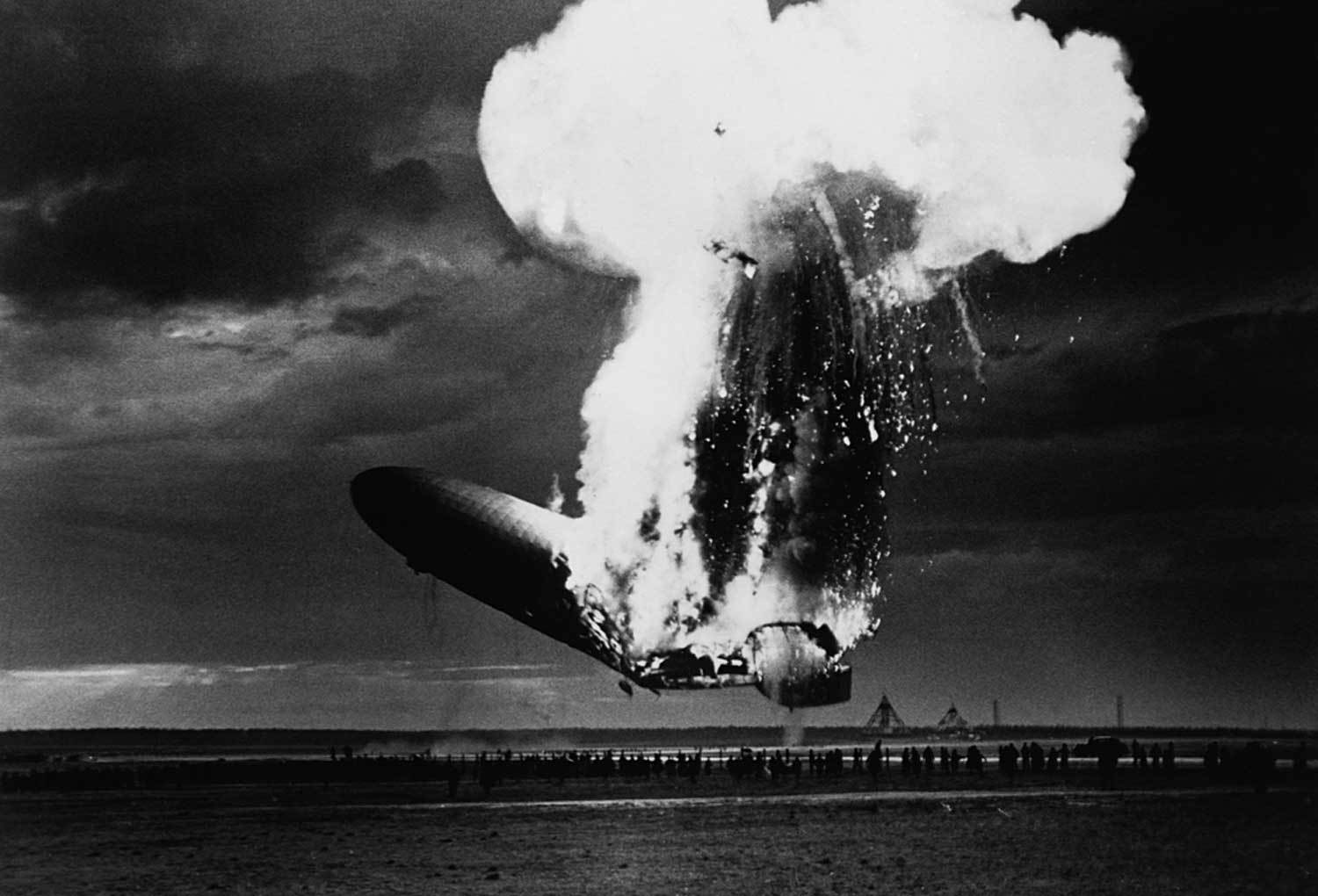
The tragic and dramatic scene was captured on newsreel and on radio by W.L.S Chicago correspondent Herbert Morrison and his sound engineer, Charlie Nehlsen. The heightened emotion in Morrison’s voice gave added piquancy to what can be read now as a barren text. He spluttered, was often lost for words, and was almost overwhelmed:
“It’s starting to rain again, it’s – the rain has slacked up a little bit. The back motors of the ship are just holding it, just, just enough to keep it from – it burst into flames! Get this, Charlie! Its fire – and it is crashing! It’s crashing, terrible! Oh my, get out of the way, please! It’s burning and bursting into flames, and the – and it’s falling on the mooring mast and all the folks agree this is terrible, this is one of the worst catastrophes in the world. It’s – it’s the flames . . . it’s a terrific crash ladies and gentlemen. It’s smoke and it’s flames now . . . and the frame is crashing to the ground, not quite to the mooring mast. Oh, the humanity, and the passengers screaming around here. I told you. I can’t even talk to people whose friends are on there. Ah! It’s – it’s – it’s – it’s . . . Oh –ohhh, I , I can’t talk ladies and gentlemen. Honest, it’s just laying there, a mass of smoking wreckage. Ah! And everybody can hardly breathe and talk, and the screaming lady, I –I’m sorry. Honest, I – I can hardly breathe. I’m going to step inside where I cannot see it. Charlie, that’s terrible. Ah, ah – I can’t. I, listen folks, I – I’m gonna have to stop for a minute because I’ve lost my voice. This is the worst thing I’ve ever witnessed.”
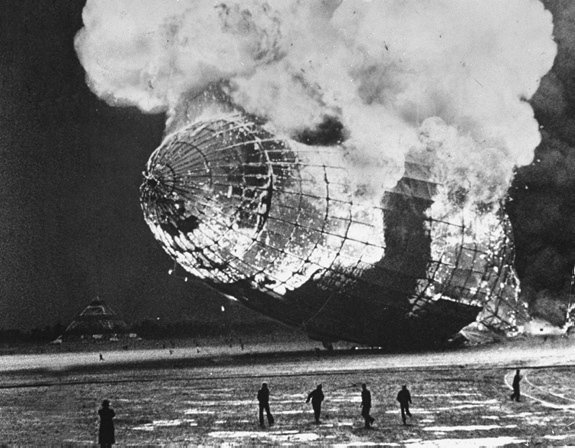
The world was in shock, this was a disaster caught on film and the carnage was there for all to see. Few could believe that this great Airship, larger than the Titanic, could be so utterly destroyed in less than a minute. Sabotage was immediately suspected of being the cause. After all, the Hindenburg was an obvious target for anyone wanting to embarrass or retaliate against the Nazi regime in Germany and there had been threats made against her in the past and surely for her to crash to the ground in a ball of flame in less than a minute could only have been caused by some kind of bomb or incendiary device on board.
One passenger in particular, was marked out for special attention. He was Joseph Spah, an acrobat and circus entertainer who had brought with him a German Shepherd puppy named Ullah. He was the only passenger who had been permitted access to the stern of the ship where the fire had been seen to break out to visit and feed his dog. He would certainly have had the opportunity to plant an explosive device. His skill as an acrobat meant that once the fire started, he was able to jump from the airship sustaining only minor injuries. He was investigated by both the F.B.I and the Gestapo in Germany but there was nothing in his background to suggest that he was harbouring a grievance, was politically motivated, or was anti-Nazi in anyway. There was also no evidence of a bomb found at the crash site, though there were traces of more than one substance that have never fully been accounted for.
Joseph Spah who was visibly shaken by the news that he was under investigation and had acted heroically in saving another man’s life before jumping from the ship was subsequently cleared of any involvement by the F.B.I. The Gestapo kept his name of file.
Another suspect was a twenty-six-year-old rigger aboard the Hindenburg, Erich Spehl. He had only recently been recruited as a member of the crew and was believed to have anti-Nazi sympathies. There was in fact little evidence for this other than the fact his girlfriend at the time was an ex-Communist. Indeed, a background check found that his father was an enthusiastic Nazi and had been a member of the party for many years.
Spehl had been one of the crewmembers who had been ordered to the ship’s stern to trim it before landing. Following the explosion, he clung on desperately as it plunged to the ground. He survived the crash but was horribly burned. Conscious in hospital he beckoned over an attendant, he wished to send a telegram to his girlfriend. It read simply – “I live”- a few hours later he died. He too was subsequently cleared of any involvement.
Some people, especially among the Nazi hierarchy, even suspected the owner of the Zeppelin Company, Hugo Eckener, from sabotaging his own ship. He had been a notable and out-spoken anti-Nazi for many years and had once been willing to put himself forward as a candidate against Adolf Hitler in forthcoming Presidential Elections if the ailing Paul von Hindenburg had been unable to stand. He had let it be known that he objected to his airships being used for propaganda purposes but the idea of him being prepared to destroy the flagship of his fleet and put passenger’s lives at risk seems unlikely.
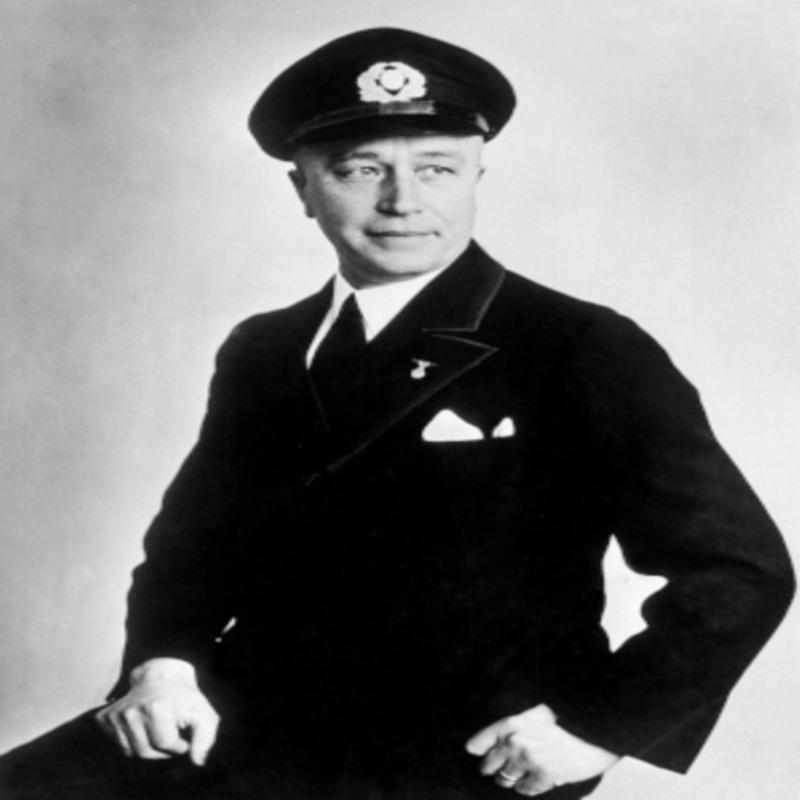
Captain Pruss who had survived the crash but had been horribly burned returned to the burning wreckage time and again to rescue survivors before being dragged away and forcibly taken off to hospital. There it was thought that he would die of his injuries, but he survived, though he was maimed and disfigured. He was to maintain at the subsequent Inquiries into the disaster and for the rest of his life that the Hindenburg had been sabotaged. He was supported in this view by his surviving junior Officers.
Hugo Eckener believed Pruss was just trying to deflect responsibility away from his own role in the tragedy. He publicly criticised Pruss for his handling of the landing. He had tried to rush it, he said, and his rough treatment of the ship and the many sharp turns he made it undergo had not only put it under unnecessary strain but had caused the stray spark that had ignited the hydrogen that led to the tragedy. The two men after a tense, terse and bitter encounter at the Official Inquiry never spoke to one another again.
The Inquiry which heard testimony from survivors, witnesses, and experts provided conflicting accounts of what might have occurred. Some of the surviving crewmen testified to seeing a flash like a small incendiary device detonating just seconds before the fire broke out. Captain Pruss was to claim that the unidentifiable substances recovered from the wreckage bore this testimony out. Others suggested that the Hindenburg had been struck and set on fire by lighting, but she had safely navigated electrical storms before without incurring anything but minor damage and no one reported seeing lighting at the time the fire broke out
.
Robert Buchanan, a member of the ground crew, testified that he had seen one of the engines backfire after being thrown suddenly into reverse causing a shower of spark which he believed had ignited hydrogen that was leaking from the roof of the ship.
Hugo Eckener favoured the view that the rough handling of the Hindenburg had caused one of the bracing wires to snap causing it to rip into and puncture some of the gas cylinders which caused the leak of hydrogen making it vulnerable to ignition. He was angered however when it was put to him that the Hindenburg simply wasn’t durable enough to tolerate sudden thrusts, turns, and movements, that she simply broke apart and that structural failure was to blame.
The Official Inquiry was to find in favour of Eckener’s view and that the most likely cause of the disaster was a gas leak in cell 4 or 5 near the stern of the ship that had been ripped open by the snapping of a wire.
It is now widely believed that the disaster was the result of the build-up of static electricity that had been caused by the electrical thunderstorm it had flown through on its way to Lakehurst and that a broken shaft or something similar had caused a puncture allowing hydrogen to leak into the ventilation shafts. When members of the ground crew took hold of the landing ropes, they effectively earthed the ship causing the fatal spark.
Though the Zeppelin Company had a good safety record Airships in general did not and in the previous years there had been a number of significant disasters. The dramatic capture of the Hindenburg’s last moments on newsreel made it the most high-profile and famous airship disaster but it was far from being the deadliest in terms of loss of life. On 5 October 1930, the British R101, had crashed into a field in Beauvais, France, after hitting power lines killing 48 of the 55 passengers on board whilst on 4 April 1933, the U.S.S Akron had crashed into the sea during a severe storm killing 73 of the 76 people aboard.
The very public and horrifying demise of the Hindenburg saw the end of the Airship as a means of commercial travel, though the Graf Zeppelin continued to operate for some months afterwards though it no longer carried passengers.
The unsuitability of the Airship for trans-Atlantic travel had been revealed in the most brutal and graphic way but the destruction of the Hindenburg aside perhaps its demise was already inevitable for just three years later on 26 March 1939, the Pan-American Yankee Clipper carried the first fee-paying passenger’s non-stop across the Atlantic Ocean by aeroplane.
It was the dawn of a new age.
Tagged as: Modern
Share this post:





